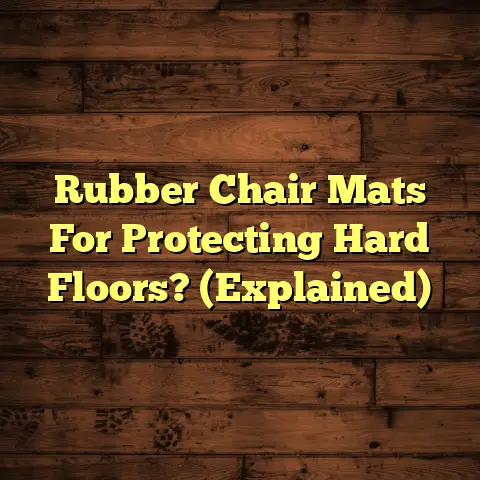Using A Steam Cleaner On Concrete: Best Practices And Tips?
But what if I told you there’s a super-effective, eco-friendly way to tackle that mess?
That’s right, I’m talking about steam cleaning!
As a flooring contractor with years of experience, I’ve seen firsthand how steam cleaning can transform concrete surfaces.
Not only does it blast away tough stains and grime, but it also eliminates allergens, bacteria, and mold without the need for harsh chemicals.
Imagine a driveway that looks brand new, a patio
ready for entertaining, and a garage floor that’s
actually clean.
Steam cleaning can make that
happen, and it contributes to a healthier
environment too!
So, let’s dive into the world of steam cleaning concrete and discover the best practices and tips to get the job done right.
Section 1: Understanding Steam Cleaning
What is Steam Cleaning?
Okay, so what exactly is steam cleaning?
Simply
put, it’s a cleaning method that uses high-
temperature steam to penetrate and lift dirt,
grime, and stains from surfaces.
The science behind it is pretty cool.
The hot steam loosens the bonds between the
dirt and the concrete, making it easy to wipe
away.
It’s like a super-powered version of
mopping, but without all the chemicals!
Types of Steam Cleaners
Now, there are a few different types of steam
cleaners you can use.
Each has its pros and cons,
depending on the size of the job and your budget.
Handheld Steam Cleaners: These are small, portable units that are great for spot cleaning and small areas. They’re easy to store and relatively inexpensive, but they might not be powerful enough for large concrete surfaces.
Canister Steam Cleaners: These are larger than handheld models and offer more power and capacity. They usually come with a variety of attachments, making them versatile for different cleaning tasks.
Commercial-Grade Steam Cleaners: These are the heavy-duty machines you’ll find in professional cleaning services. They offer the highest steam pressure and capacity, making them ideal for large, heavily soiled concrete surfaces.
Steam Cleaning vs. Other Methods
You might be wondering, “Why steam cleaning over pressure washing or just scrubbing?”
Well, here’s the deal:
Pressure Washing: While effective at blasting away dirt, pressure washing can damage concrete if not done carefully. The high pressure can erode the surface and even cause cracks.
Scrubbing: This is a lot of elbow grease, and it often requires harsh chemicals to get the job done. Plus, it’s time-consuming and can be tough on your back.
Steam cleaning, on the other hand, is gentle on
concrete while still being incredibly effective.
It doesn’t require harsh chemicals, and it’s
relatively easy to use.
According to the EPA, reducing chemical usage in cleaning practices can significantly lower indoor air pollution and promote better health.
Steam cleaning aligns perfectly with this goal,
offering a safer and more sustainable cleaning
solution.
EPA – Safer Choice
Section 2: Preparing for Steam Cleaning
Clearing the Area
Before you even think about firing up that steam
cleaner, you need to prep the area.
This means
clearing away any furniture, debris, and loose
dirt.
Think of it like prepping a canvas before
painting.
You want a clean, clear surface to work
with.
- Sweep or vacuum the concrete surface: Get rid of any loose dirt, leaves, or debris.
- Remove any furniture, planters, or other items: You don’t want to accidentally steam clean your patio furniture!
- Clear any obstacles: Make sure you have a clear path to move the steam cleaner around.
Checking for Damage
Next up, inspect the concrete surface for any
cracks or damage.
Steam cleaning can exacerbate
existing problems, so it’s important to address
them beforehand.
- Look for cracks: Small cracks are usually not a big deal, but large cracks should be repaired before steam cleaning.
- Check for crumbling or flaking concrete: This could be a sign of more serious damage.
- Be aware that steam cleaning can highlight existing damage: It might make cracks or blemishes more noticeable.
Protecting Adjacent Surfaces
Finally, protect any adjacent surfaces that could
be damaged by steam or water.
This includes
plants, walls, and outdoor furniture.
- Cover plants with a tarp: This will protect them from the hot steam.
- Use painter’s tape to protect walls: This will prevent water from seeping into the paint.
- Move any furniture away from the area: If you can’t move it, cover it with a tarp.
Section 3: Best Practices for Using a Steam Cleaner on Concrete
Step-by-Step Guide
Alright, let’s get down to the nitty-gritty.
Here’s a step-by-step guide on how to effectively
use a steam cleaner on concrete surfaces:
Preheat the Steam Cleaner: Follow the manufacturer’s instructions for preheating the steam cleaner. This usually takes about 5-10 minutes.
Optimal Temperature Settings: For concrete, you’ll want to use the highest temperature setting possible. This will ensure that the steam is hot enough to penetrate and lift dirt and grime. Most steam cleaners reach temperatures between 200°F and 250°F.
Applying Steam: Hold the steam cleaner nozzle a few inches above the concrete surface and move it in consistent, overlapping patterns. Avoid holding the nozzle in one spot for too long, as this could damage the concrete.
Focusing on Tough Stains: For stubborn stains, use a back-and-forth motion and apply more pressure. You may also want to pre-treat the stain with an eco-friendly cleaner before steam cleaning.
Using Attachments: Many steam cleaners come with attachments like brushes or pads. These can be helpful for scrubbing away tough stains and grime. Stiff-bristled brushes are usually best for concrete.
Managing Steam Pressure and Flow: Start with a lower steam pressure and gradually increase it until you find the optimal setting. Be careful not to use too much pressure, as this could damage the concrete.
Working in Small Sections: Clean the concrete in small sections, about 2-3 feet at a time. This will ensure that you’re thoroughly cleaning each area.
Additional Tips
Here are a few more tips to keep in mind:
- Keep the steam cleaner moving: Don’t let it sit in one spot for too long.
- Overlap your passes: This will ensure that you’re not missing any spots.
- Wipe up excess water: Use a clean cloth or mop to wipe up any excess water as you go.
Section 4: Tips for Achieving the Best Results
Ideal Timing
When’s the best time to steam clean your concrete?
Well, it depends on where you live.
Spring and Summer: These are generally the best times to steam clean outdoor concrete surfaces. The weather is warm and dry, which will help the concrete dry quickly.
Avoid Extreme Temperatures: Don’t steam clean concrete when it’s freezing cold or scorching hot. Extreme temperatures can damage the concrete.
Pre-Treating Stains
For really tough stains, consider pre-treating them with an eco-friendly cleaner before steam cleaning.
Baking Soda Paste: Mix baking soda with water to create a paste and apply it to the stain. Let it sit for 30 minutes before steam cleaning.
Vinegar and Water: Mix equal parts vinegar and water and spray it on the stain. Let it sit for 15 minutes before steam cleaning.
Regular Maintenance
To keep your concrete looking its best, it’s important to establish a regular cleaning schedule.
- Sweep or vacuum regularly: This will prevent dirt and debris from building up.
- Steam clean every few months: This will help remove stains and grime before they become too difficult to remove.
- Seal the concrete: Sealing the concrete will help protect it from stains and damage.
Personal Anecdote
I remember one time, a client of mine had a
driveway that was covered in oil stains.
They had
tried everything to get rid of them, but nothing
worked.
I suggested steam cleaning, and they were
skeptical at first.
But after just one steam cleaning session, the oil
stains were gone!
They were amazed at how
effective it was.
Section 5: Troubleshooting Common Issues
Insufficient Steam
What if your steam cleaner isn’t producing enough
steam?
Here are a few things to check:
- Check the water level: Make sure the water tank is full.
- Check the heating element: The heating element might be faulty.
- Check for clogs: There might be a clog in the nozzle or hose.
Excessive Moisture
If you’re noticing excessive moisture or water pooling on the surface, try these tips:
- Use a lower steam pressure: Too much pressure can cause water to pool.
- Wipe up excess water: Use a clean cloth or mop to wipe up any excess water as you go.
- Improve ventilation: Open windows or doors to improve ventilation.
Stubborn Stains
Some stains just won’t come out with steam alone. Here’s what to do:
- Pre-treat the stain: As mentioned earlier, pre-treating with an eco-friendly cleaner can help.
- Use a brush attachment: A stiff-bristled brush can help scrub away tough stains.
- Repeat the steam cleaning process: Sometimes it takes a few tries to remove a stubborn stain.
Maintaining Your Steam Cleaner
To ensure your steam cleaner lasts for years to come, it’s important to properly maintain it.
- Empty the water tank after each use: This will prevent mineral buildup.
- Clean the attachments: Clean the attachments with soap and water after each use.
- Descale the steam cleaner: Follow the manufacturer’s instructions for descaling the steam cleaner.
Section 6: Eco-Friendly Aspects of Steam Cleaning
Reducing Chemical Usage
One of the biggest benefits of steam cleaning is
that it reduces the need for chemical cleaners.
This is great for the environment and for your
health.
- No Harsh Chemicals: Steam cleaning uses only water, so you don’t have to worry about harsh chemicals harming the environment or your family.
- Reduces Pollution: By reducing chemical usage, you’re also reducing pollution.
Safer for Residents
Steam cleaning is also safer for residents, especially those with allergies or sensitivities to chemicals.
- Allergen Reduction: Steam cleaning can help reduce allergens in your home.
- Safer for Pets: Steam cleaning is also safer for pets, as they won’t be exposed to harsh chemicals.
Statistics
According to a study by the Environmental
Protection Agency (EPA), the average household
uses about 25 gallons of chemical cleaners per
year.
EPA – Household Chemicals
By switching to steam cleaning, you can significantly reduce your chemical usage and help protect the environment.
Conclusion
So, there you have it!
Steam cleaning is a
practical, efficient, and eco-friendly solution
for maintaining your concrete areas.
It not only enhances the appearance of your driveway, patio, or garage floor, but it also contributes to a healthier environment by eliminating bacteria and mold without the use of harsh chemicals.
I encourage you to try steam cleaning on your
concrete surfaces and experience the
transformation for yourself.
You might be
surprised at how easy and effective it is!
Ready to give it a try?
Grab your steam cleaner
and get ready to transform your concrete surfaces!
You won’t regret it.





